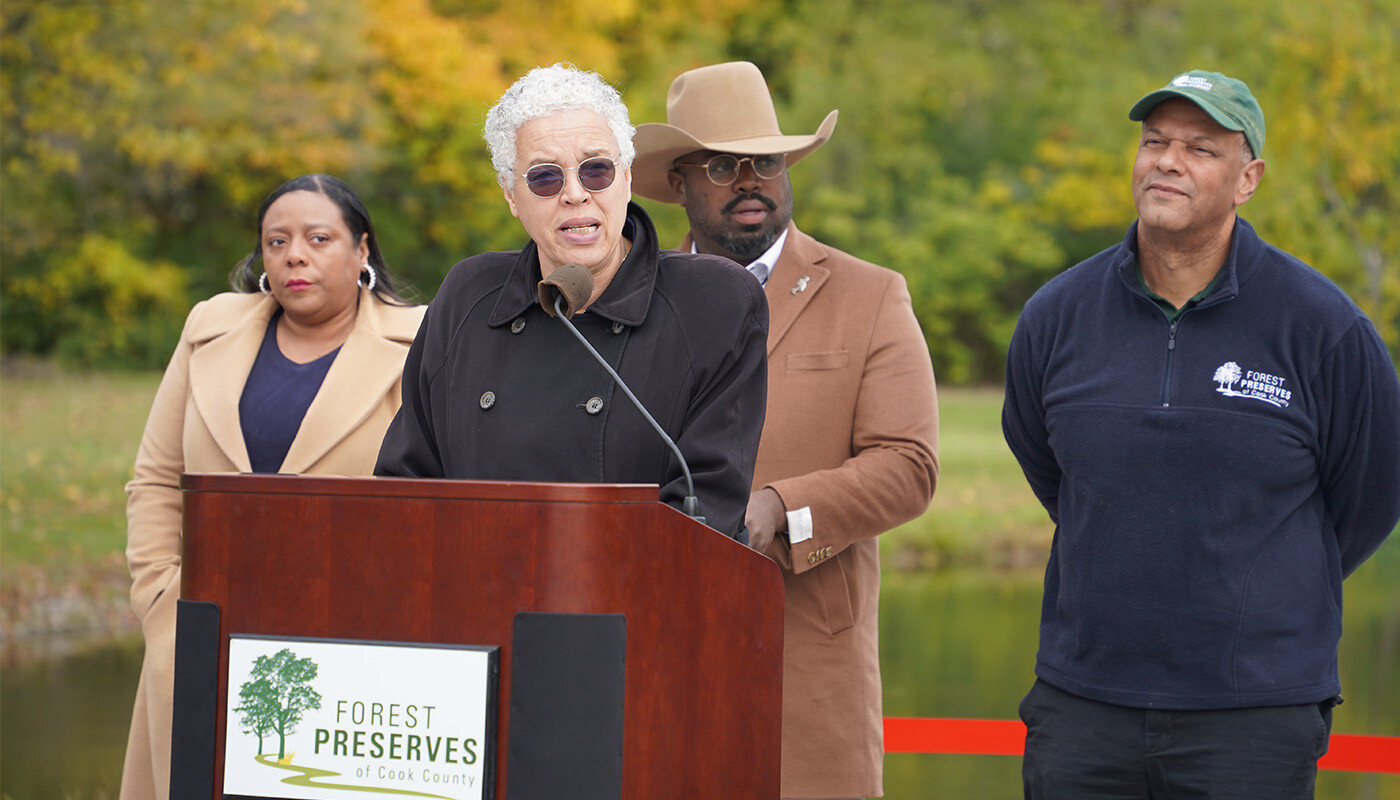Three-year-long conservation effort adds green space and reconnects waterways to bring back declining bird species, fish and alleviate flooding on the Southeast Side of Chicago
Audubon Great Lakes, the Forest Preserves of Cook County, and partners at the Great Lakes Commission, and National Oceanic and Atmospheric Administration (NOAA) have completed a significant restoration project at Powderhorn Lake preserve, restoring more than 100 acres of wetlands and reconnecting Powderhorn Lake to Wolf Lake, creating improved habitats for birds, fish and other wildlife to thrive.
The project was celebrated at a ribbon-cutting this morning by Forest Preserves of Cook County President Toni Preckwinkle, Forest Preserves General Superintendent Arnold Randall, Audubon Great Lakes Executive Director and Vice President Michelle Parker, National Audubon SocietyChief Conservation OfficerMarshall Johnson, and other elected officials and agency representatives.
“Today, we celebrate a fascinating and cutting-edge restoration project. Thanks to our valued partners, this area of the Southeast Side will flourish with enhanced habitats, providing sanctuary to native plants, fish, birds and other diverse wildlife. And it is great for people too—more fishing, more birdwatching, less flooding, and the preservation of additional green spaces within our urban community,” Preckwinkle said.
Powderhorn Lake Forest Preserve, the most biodiverse area in the city of Chicago, is home to about 250 plant species, 2,500 insects and 200 bird species. The 50-acre freshwater lake is embedded within one of the few remaining examples of dune-and-swale topography—parallel sandy ridges alternating with low wetlands—which once characterized the Calumet Region but now is considered globally rare. In 2007, 130 of the preserve’s 192 acres were designated as the Powderhorn Prairie and Marsh Nature Preserve, the only state-dedicated nature preserve within Chicago city limits.
Like many locations across the Calumet Region, however, a century of urban and industrial development fundamentally altered the natural conditions at the site. Powderhorn Lake was separated from its northern neighbor, Wolf Lake, which connects to Lake Michigan, and heavy rains and wet springs have led to high water levels that allowed invasive species to take hold and contributed to flooding in neighboring communities.
“The restoration of this important coastal wetland is a win for wildlife, and a win for people who value this incredible resource. Connecting waterways is no small feat. It takes a team of partners, and dedicated staff and volunteers, and together we celebrate a huge conservation accomplishment,” said Parker. “Great Lakes populations of breeding marsh birds have declined significantly over the past 30 years, but the good news is the restoration and reconnections of the waterways has reestablished vital marsh habitat that marsh birds and fish need to thrive – and we are already seeing signs of these at-risk species and other wildlife coming back to the region.”
Through an innovative conservation and engineering approach, the two bodies of water are now linked by a half-mile connection that runs both above ground through creeks, and underground through pipes that are big enough for fish and turtles to pass through. Powderhorn Lake’s northern shallows will once again act as an effective fish nursery, while the connection to Wolf Lake allows fish to move between lakes, which will bolster populations of game and non-game fish, including Northern Pike, Yellow Perch and Grass Pickerel.
As part of the restoration, two water control structures were installed to maintain the delicate but important balance of water and plant life. These structures will allow land managers to adjust the water level at Powderhorn lake as needed. With unnaturally high water levels present, Forest Preserves staff can open the water control structure, lowering water levels by draining water from Powderhorn Lake into Wolf Lake and eventually Lake Michigan.
“During dry seasons, the new water control structures will be closed to help water levels rise. Higher water levels will help manage harmful invasive species and create the hemi-marsh habitat that breeding marsh birds like the Least Bittern, Common Gallinule and Pied-billed Grebe rely on for survival,” added Parker.
The restoration also benefits communities, who will experience flood relief and the return of natural spaces and wildlife to the area, as birds and fish find refuge in the restored habitat. Audubon Great Lakes and the Forest Preserves of Cook County plan to continue engaging the community by hosting volunteer workdays for local community members that would like to get involved helping with continued restoration including planting, and seed dispersal.
“This project shows what we can achieve when government agencies, nongovernmental organizations, and the private sector collaborate,” said Erika Jensen, executive director of the Great Lakes Commission, which provided funding through a partnership with NOAA. “Nearly $1.2 million of Great Lakes Restoration Initiative funds were directed to Powderhorn Lake, resulting in the restoration of 192 acres of wetland habitat, 630 linear feet of stream habitat, and 45 acres of native vegetation. Projects like this provide both ecological and economic benefits such as increased property values, demonstrating the strong return on investment of restoring and protecting the Great Lakes.”
To ensure that habitat is ideal for fish and marsh birds beyond this project, Audubon Great Lakes and the Forest Preserves of Cook County are working together to monitor marsh bird presence, wetland vegetation and water levels. Combining all this data will allow experts to continue to properly manage water levels together.
Other officials attending and speaking at the ribbon-cutting event on October 23 included Cook County Forest Preserves Commissioner Stanley Moore, Cook County Forest Preserves Commissioner Monica Gordon, Kevin O’Donnell with the Environmental Protection Agency, Jill Estrada with the Great Lakes Commission and Chip O’Leary with the Illinois Department of Natural Resources.
Funding for the Powderhorn project is provided by the Great Lakes Restoration Initiative (GLRI) and U.S. Environmental Protection Agency through the National Oceanic and Atmospheric Administration (NOAA)/Great Lakes Commission (GLC) Regional Partnership.
###
About the Forest Preserves of Cook County
Don’t you sometimes just want to escape? Explore the natural beauty of Cook County for an hour, a day or even a night. When you’re surrounded by 70,000 acres of wild and wonderful there’s no better place to feel free.

